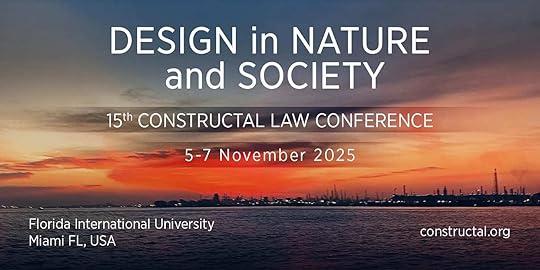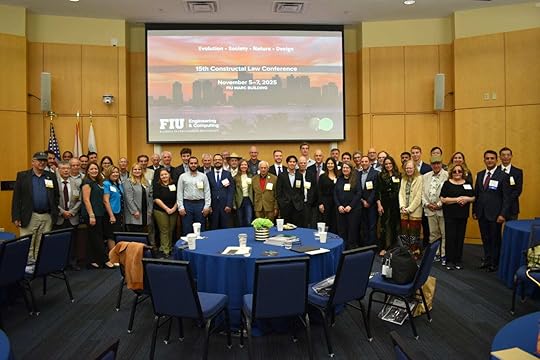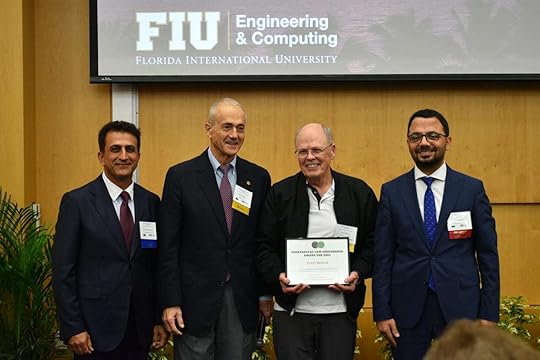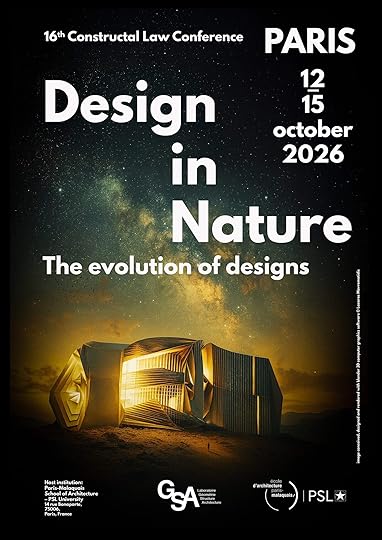Adrian Bejan's Blog
November 22, 2025
Adrian Bejan | Trunk, Canopy, Diversity, from Design in Nature
The video draws the trunk and the canopy in profile, sets the coordinate from the tip, and brings in a uniform wind that sees the big, so the drag per unit height acts on the canopy and builds a bending moment that the trunk must carry, with tensile in the dorsal fiber and compressive in the ventral fiber, and by asking for equal maximum allowable stress along the height the drawing leads to the lightest design, where the trunk shape follows from the same degree of freedom that sets the canopy. The result is that trunks are essentially conical. In contrast, canopies exhibit diversity without conflict with performance, with the Eiffel Tower shown as the tree with the sharpest top, all trunk and no canopy, carrying the pushing from the side through a truss-like structure.
The drawing sets the diameter of the trunk as a function of location, the canopy size as a function of its own level, and a uniform wind with frontal view and speed, so the drag per unit height is read as a slice-by-slice force that tries to turn the top clockwise while the trunk takes that load.
The bending moment at a given altitude is calculated by integrating the arrows of force with their arms, and the counter moment in the trunk comes from stresses that vary linearly across the section, with the area moment of inertia and the local diameter determining how the section resists.
By requiring the maximum allowable stress to be the same everywhere along the height, the drawing declares equal SMA and establishes a constant relationship between bending moment and diameter, so the trunk profile follows directly from the wind loading and the way the section works.
The canopy is treated as a power in its coordinate, which introduces a degree of freedom; the same degree of freedom appears in the trunk profile. Yet, the outcome is that for a cone, the trunk is a cone, for a round top, the trunk is very close to one, and for a Christmas tree with a sharp tip, the trunk is again very close to one, so the trunk shape is relatively insensitive to the crown.
The message is that diversity shows up at the largest scale, in the canopy that the wind sees. At the same time, the trunk remains essentially conical and transports the water flow rate upward per unit of volume. The example of the Eiffel Tower shows a tree with all trunk and no canopy, with a distribution of maximum allowable stresses through a truss-like structure that does not break under lateral forces.
I enjoy putting together Umit Gunes on the Constructal Law, and I’m glad to share it with you for free. I hope you find it engaging and worthwhile. Preparing each post takes considerable time and effort, so if you appreciate Umit Gunes on the Constructal Law‘s content and can support it, please consider choosing one of the paid subscription options.
November 13, 2025
Adrian Bejan | Root shape, from Design in Nature
The video asks for the shape of a root that maximizes water production, treating the root as a solid body of revolution in wet soil, with the ground at the top and the vertical z-axis pointing upward. Water seeps from the ground into the root and then upward through a bundle of tubules, driven by a pressure difference and hindered by viscosity, while the pressure in the ground is higher than above ground. Inside the root, the average speed in the vertical direction and the transversal velocity in the radial direction are linked to permeability, so the mass flow rate at ground level follows from how the diameter at altitude z is drawn under a volume fixed constraint. With these pieces, the profile that carries more water emerges, and the conclusion is a conical root, along with the lesson that big roots convey high water flow rates out of the ground.
The drawing sets radial and vertical coordinates, pressure in the ground, pressure inside the root, and pressure above ground, then reads seepage upward with average speed in the vertical direction and transversal inflow from the wet soil, both expressed with permeability and viscosity, so the pressure difference along the height explains why water moves from high to low inside the root.
The root interior is a bundle of tubules, like very narrow straws, so water moves with great difficulty and leaves a trace of pressure that decreases upward. This picture supports using Darcy’s law in the vertical and radial directions, with permeability in the z direction greater than in the transverse direction, which matches the idea of a shell that channels water along the height.
A small slice between altitude z and z plus a small increment balances what enters from below and from the side with what exits above, using the wetted perimeter, lateral area, and cross-sectional area to write the mass flow rate in terms of the average speeds, so the relation between vertical and radial motions links shape and production at the top.
The fixed-volume condition resolves the problem, and the profile is assumed to be a power law in altitude, together with a power law for the pressure excess inside the root. Reading the exponents reveals that the diameter grows linearly with height. Hence, the shape is conical, and the constants follow from the same set of statements without changing the physical picture.
The mass flow rate at ground level rises with size, so big roots and big trees are big water pumps. The final message is that the conical root, with the given volume fixed and the pressure difference maximized, maximizes production, which explains why the shape and the flow belong in the same drawing.
I enjoy putting together Umit Gunes on the Constructal Law, and I’m glad to share it with you for free. I hope you find it engaging and worthwhile. Preparing each post takes considerable time and effort, so if you appreciate Umit Gunes on the Constructal Law‘s content and can support it, please consider choosing one of the paid subscription options.
November 7, 2025
Adrian Bejan | Vegetation and Hair, from Design in Nature
The video turns to vegetation and hair, asking what flows in a tree, why plants come before animals, and why the drawing of trees in a forest looks so much like the drawing of hair and fur on the skin of animals. The main answer is that water flows from the ground into the dry wind through root, trunk, canopy, corona and forest, while stresses from the wind on the crown flow down into the ground, so vegetation transfers from high to low, from plenty to very little, and later hair and fur appear on animals to slow the flow of heat from skin to dry air by trapping a blanket of air between strands, which shows that the same kind of drawing can either facilitate flow or prevent it, depending on purpose.
The picture of the tree shows a root deep in the soil, a trunk rising, branches gathered in a canopy or corona like a crown, and the forest as a whole, so that water can reach the dry wind while stresses from the wind on the crown can reach the ground.
The first question is what flows in a tree, and the answer is water. So trees are where water is plentiful, and trees are absent in the desert. At the same time, a bundle of stresses from the wind flows down the trunk into the ground.
Vegetation happens before the rest of the biosphere, before the animate, so that later the moving animal, the tree walker, has greater access to the stationary tree, whose canopy gives access to water and access to wind at a height that a small plant does not reach.
In profile, the same kind of drawing appears again on animals, where hair and fur on the skin meet the dry air, and hair is there for the purpose of preventing the flow of heat from skin to dry air by trapping air between strands.
The forest drawing shows that trees do not like neighbors and never touch; each tree wants access to dry air all by itself, while hair on skin is dense and close so that air between filaments is slowed down and kept as an insulation blanket from which the living animal benefits.
November 6, 2025
The 15th Constructal Law Conference (CLC2025) has Started at Florida International University

The 15th Constructal Law Conference (CLC2025) has started on November 5 at Florida International University, bringing together leading thinkers from around the world to explore design in nature and flow architectures across disciplines. The opening sessions featured inspiring keynote speeches and vibrant discussions reflecting the growing global interest in the Constructal Law and its applications. 42 distinguished presentations will be delivered in 3 days, each contributing unique insights into the science of flow systems.
 Group photo of the 15th Constructal Law Conference (CLC2025)
Group photo of the 15th Constructal Law Conference (CLC2025) This year, the prestigious Constructal Law Conference Award was presented for the second time. The 2025 recipient, Terry Bristol, was awarded for the philosophical and historical foundations of thermodynamics and the engineering worldview. His work bridges science and philosophy, offering a deeper understanding of the creative patterns that govern both natural and human-made systems.
 Award photo with Terry Bristol
Award photo with Terry BristolThis anniversary edition of the 16th Constructal Law Conference (CLC2026) — Design in Nature will be hosted for the first time in Paris and, notably, for the first time in a School of Architecture: the Paris-Malaquais School of Architecture – part of PSL (Paris Sciences et Lettres) University, in the heart of Saint-Germain-des-Prés.

November 2, 2025
The 16th Constructal Law Conference (CLC2026)
In 2026, the constructal community marks a milestone: the 30th anniversary of the Constructal Law—the idea that flow systems (from rivers and lungs to designs, cities, and technologies) evolve to provide easier access to the currents that move through them. Over three decades, this community has grown into a vibrant, transdisciplinary network with more than 7,500 peer-reviewed articles in Q1–Q2 journals across engineering, biology, ecology, geophysics, materials science, computer science, network science, art, architecture, urban planning, economics, and cultural studies.
This anniversary edition of the 16th Constructal Law Conference (CLC2026) — Design in Nature will be hosted for the first time in Paris and, notably, for the first time in a School of Architecture: the Paris-Malaquais School of Architecture – PSL University, in the heart of Saint-Germain-des-Prés. This historic setting—shared with the Beaux-Arts de Paris—has long cultivated experimentation and research. With nearly 90 permanent faculty and 200+ external contributors across six multidisciplinary departments, Paris-Malaquais is uniquely positioned to convene architects, engineers, scientists, and artists who share a common language of flow, form, and evolution.
Since 2025, as a member of PSL (Paris Sciences et Lettres) University—consistently ranked among the world’s top 50—Paris-Malaquais connects participants to one of Europe’s richest academic ecosystems, with shared services, libraries, and a growing network of international partners.
 Themes & Tracks
Themes & TracksThis year’s theme—Design in Nature: The evolution of designs—invites contributions that connect physics, life, culture, philosophy, architecture, urbanism, and the built environment. Tracks include:
The Physics of Life: Flow architectures in living systems, from cells to ecosystems.
Design in Nature: Universal forms in rivers, trees, lungs, turbulence, architectures, and artworks.
Evolutionary Design with Freedom: How systems evolve when free to morph—organisms, environments, cities, technologies, art.
Evolution Across Scales: Geophysical, celestial, biological, social, technological, cultural, and literary flows.
Thermodynamics, Energy, Power, and Economy: Efficiency, entropy, movement, access, and societal structures.
Thermoeconomics, Bioeconomy & Circular Economy: Flow-based models for sustainable futures.
Information, Complexity & the Arrow of Time: Irreversibility, creativity, and cultural memory.
Humans as Part of Nature: Anthropological and artistic perspectives on our place in natural flows.
Hierarchy, Power Laws, Diversity, Inequality & Innovation: Patterns of distribution and creativity across systems.
Living & Non-Living Through the Same Lens: Unified perspectives on animate and inanimate design.
Architecture as Flow Design: Buildings and spatial systems as flow architectures; adaptive structures, ventilation and circulation, tree-shaped structural design.
Urbanism & Tree-Shaped Structures: River basins, transport systems, and cities as natural flow networks; branching and timing logic of streets and infrastructures.
Natural & Social Sciences Together: Transdisciplinary models of evolution and change.
Art & Science Together: Architecture, music, visual arts, literature, and performance as flow systems with staying power.
Predicting Evolution: Forecasting natural, social, technological, and cultural futures.
Why Paris-Malaquais?Because today’s ecological urgencies and the rise of artificial intelligence demand design freedom grounded in physics and open inquiry. Paris-Malaquais nurtures exactly that: research-driven, dogma-free experimentation—a culture where architects, engineers, scientists, and artists rethink how forms flow and persist.
Join us in Paris to explore how designs in nature—and in culture—evolve to make movement easier, access broader, and life more possible. The world of tomorrow cannot thrive without architects and designers who understand flows—and help make the world a home.
November 1, 2025
Adrian Bejan | Columns and Skeletons, from Design in Nature
The video follows beams, columns, trusses, and skeletons from dried mud and fired brick to iron bridges, skyscrapers, and concrete, and shows how shape, weight, and buckling decide what survives. Concrete is stronger in compression than in tension, so steel-reinforced concrete places steel rods where the tensile stresses live. The drawing matters because the lightest structure comes from eliminating what is not stressed and keeping only what works. From the balcony crack to the skeleton of the Statue of Liberty and the Eiffel Tower, the same view repeats in nature and in man-made structures. The forest adds wind and water: vertical parts bend in the wind, and everything that grows on land pumps water upward, so flow and support belong in the same drawing.
Concrete resists compression better than tension, so a beam snaps where the upper fiber in tension reaches the maximum allowable stress, which is why a crack on an old balcony appears near the fixed end. Steel-reinforced concrete places longitudinal steel rods near the surface that carry most of the tensile stresses, and the cross section allows more metal where it works and less where it does not.
The drawing is a way to decide where to keep material and where to remove it. The rule is to find the piece that is not stressed and eliminate it, which explains why trusses look open, why the inside of the Eiffel Tower looks like a lattice, and why the skeleton of the Statue of Liberty carries load with little wasted material.
Columns and skeletons show that a few supports that do not buckle can be better than many skinny ones. A three-part shape with a trunk and two legs teaches that the V or great lambda is a good way to carry weight, and that the proportion of torso and legs can be read from buckling limits.
Bigger things require bigger cantilever parts, and cheaper materials make them possible. Antiquity used dried mud; the Roman Empire used fired brick; the spread of iron bridges led to taller buildings; and concrete made columns, beams, and skeletons on a large scale, provided their shapes respected bending and buckling.
The forest shows vertical parts embedded in the ground that are blown from the sides by the wind and bent, while everything that grows on land pumps water upward into the dry wind. Animals go to where the water is and act as water trucks, so support and flow are joined in one picture.
October 25, 2025
Adrian Bejan | The last bastion of the merit system, from Thermodynamics
October 15, 2025
Adrian Bejan | I beam cross section, from Design in Nature
The video examines a family of drawings spread across a space using two simple moves, tapering and hollowing, and demonstrates how the expense decreases as you transition from a solid round rod to a hollow tube, then to a tapered solid beam, and finally to a hollow tapered tube. It then turns the drawing on its side and reads the cross-section. Only the top fiber and bottom fiber are doing the most challenging work, while the material near the neutral plane sits idle. The drawing removes the idle part, retains the two hard workers, and connects them with a thin plate, allowing them to bend as one. This is the idea behind the I profile and the reason the useful material lives far from the neutral plane.
The picture builds a map of designs in two directions, one for tapering and one for hollowing, and marks spending steps at twelve, six, four, and two, which invites the thought of going even lower, like sliding down an apron on a slope covered by snow.
By examining the hollow tapered tube in cross section, the video identifies equality at the top and bottom fibers, then observes the equator near the neutral plane as being lazy and ready for removal, thereby clearing a path to a leaner shape.
Keeping only two free fibers makes the object limp like a wire, since they bend on their own. To address this, the drawing adds a plate that ties them together, ensuring plane cross sections remain plane as they bend.
The thin plate is the web that connects the dorsal fiber and the ventral fiber. It is treated as massless in the spending picture, yet it makes the section act as one piece and gives the letter I in profile, with the most rigid working material kept far from the neutral plane.
The message is to give the drawing more freedom, take out lazy material around the equator, and keep the work spread where it counts, so the I beam idea lets the design move beyond the valley marked by two while staying honest about where the work is done.
---
Umit Gunes, Ph.D.
Assoc. Prof. | Yildiz Technical University
Coordinator | Constructal Law Conference
Editor | International Communications in Heat and Mass Transfer
Guest Editor | Philosophical Transactions of the Royal Society A
Guest Editor | BioSystems
Web | umitgunes.com
October 13, 2025
Adrian Bejan | Tapered cantilever beam, from Design in Nature
Under the same loading, deflection, material, and maximum allowable stress, the video demonstrates the effect of changing the drawing from a solid round rod to a hollow tube. To a tapered solid beam, and finally to a hollow tapered tube makes the volume requirement smaller, because hollowing removes the inactive core and tapering reshapes the profile so that the outer fibers carry equal work, which leads to a round nose shape and to the simple rule that change in architecture corresponds to change in performance, with the combined use of hollowing and tapering giving the most efficient result in volume units.
Hollowing removes the inactive core and leaves an annulus with diameter, wall thickness, and length chosen so that stiffness and deflection match the starting case. This shifts work to the material that counts, lowering the expenditure to six volume units without altering the material.
Tapering keeps the beam solid and redistributes material along the span to avoid stress concentration at sharp features. With the same conditions, the tapered round beam reaches four volume units, demonstrating how one degree of freedom in shape multiplies the gain.
Using hollowing together with tapering sets the dorsal fiber and the ventral fiber at the maximum allowable stress from the clamp to the tip. The profile ends in a round nose and removes the inactive core while keeping the fibers equally loaded.
The round nose is selected to prevent breaking where sharp protrusions or indentations would concentrate stress. The bending moment, combined with the area moment of inertia, guides a smooth shape that can withstand the load with minimal material.
---
Umit Gunes, Ph.D.
Assoc. Prof. | Yildiz Technical University
Coordinator | Constructal Law Conference
Editor | International Communications in Heat and Mass Transfer
Guest Editor | Philosophical Transactions of the Royal Society A
Guest Editor | BioSystems
Web | umitgunes.com
September 26, 2025
Adrian Bejan | Tree branches, equality in failure, from Design in Nature
The video explains how the evolution of solid structures follows the same logic as flow systems, aiming for efficiency, adaptability, and survival. The example of a beam under load introduces the connection between stiffness, strength, and material economy. From simple cantilever beams to tree branches and bones, the goal is always to minimize material while maintaining equal strength and stability throughout. The process of removing underused material leads to forms where stress is distributed uniformly, revealing nature’s preference for equality in failure and optimal use of resources.
The analysis begins with a beam loaded at its tip. Its stiffness is measured by how much it bends, and its strength by how much stress it can withstand before failure. These concepts, grounded in the work of early scientists like Navier and Cauchy, illustrate that every structure resists load through an internal balance of stress, where geometry and material properties determine performance.
The calculation shows that the highest stresses occur at the beam’s fixed end, where both the bending moment and the distance from the neutral axis reach their maximum. Cracks in balconies or branches appear there first, proving that local geometry controls vulnerability. The challenge in design is to reduce unused material without lowering stiffness or allowing stresses to exceed the allowable limit.
By gradually reshaping the structure to equalize stress, material is removed from areas that bear less load and added to those that bear more. This transformation leads to organic forms similar to bones or branches, which look irregular but are actually optimized for even stress distribution. These shapes are examples of “perfectly morphed” designs, where every part works equally hard.
Observations after a hurricane revealed that fallen branches were not just small or weak but of all sizes. This discovery demonstrated that the tree’s architecture had achieved equality in failure. Each branch, large or small, was loaded to the same maximum allowable stress, showing that nature builds for uniform readiness to fail rather than concentrating weakness in specific parts.
The conclusion links this principle of equal stress and proportional material use to broader patterns in nature. From single beams to branching trees and forests, the same rule of uniformity governs form and function. The result is a natural hierarchy of shapes that achieve maximum performance with minimum material, guided by the pursuit of structural harmony and balance.
---
Umit Gunes, Ph.D.
Assoc. Prof. | Yildiz Technical University
Editor | International Communications in Heat and Mass Transfer
Guest Editor | Philosophical Transactions of the Royal Society A
Guest Editor | BioSystems
Web | umitgunes.com



